RENAULT MEGANE SPORT TOURER 2015 X95 / 3.G Manual PDF
Manufacturer: RENAULT, Model Year: 2015, Model line: MEGANE SPORT TOURER, Model: RENAULT MEGANE SPORT TOURER 2015 X95 / 3.GPages: 268, PDF Size: 5.01 MB
Page 71 of 268

1.65
ON-BOARD COMPUTER: trip settings (2/6)
The display of information shown below DEPENDS ON THE VEHICLE EQUIPMENT \
AND COUNTRY.
Examples of selectionsInterpreting the display selected
Current Current
Current fuel consumption.
This value is displayed above a speed of approximately 18
mph (30 km/h).
7.4 L/100
7.4 L/100
Estimated range with remaining fuel.
This range takes into account the average fuel consumption
since the last time the reset button was pressed. The value
is displayed after driving 400 metres.
Range
Range
541 km
541 km
Distance travelled since the last reset.
Distance
Distance
52.2 km
359 km
Average speed since the last reset.
The value is displayed after driving 400 metres.
Average
Average
89.6 km/h
89.6 km/h
Page 72 of 268
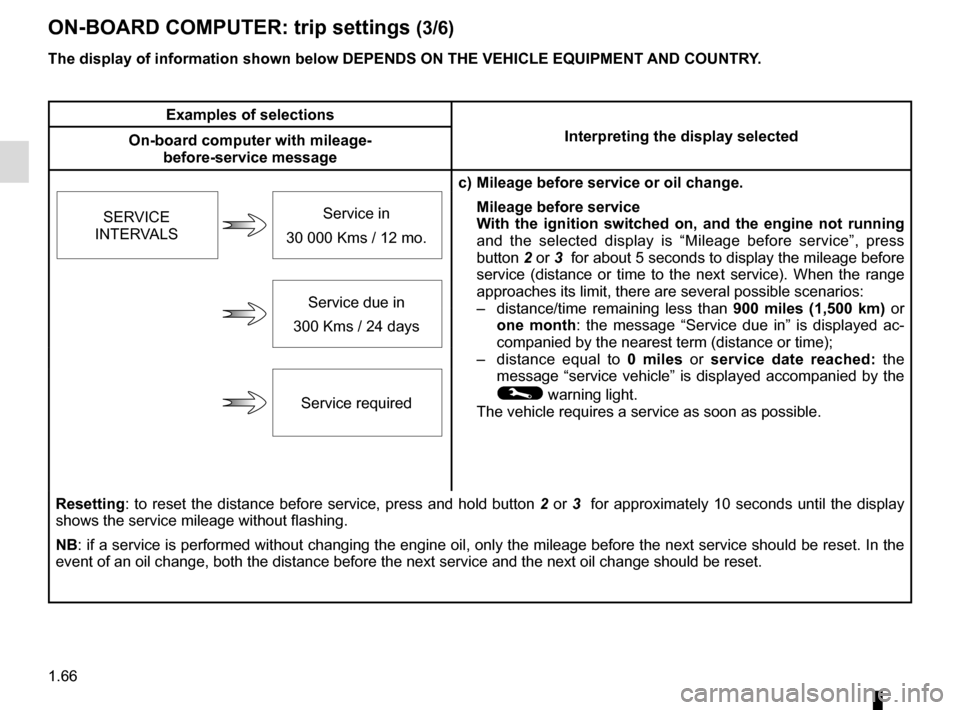
1.66
ON-BOARD COMPUTER: trip settings (3/6)
The display of information shown below DEPENDS ON THE VEHICLE EQUIPMENT \
AND COUNTRY.
Examples of selectionsInterpreting the display selected
On-board computer with mileage-
before-service message
c) Mileage before service or oil change.Mileage before service
With the ignition switched on, and the engine not running
and the selected display is “Mileage before service”, press
button 2 or 3 for about 5 seconds to display the mileage before
service (distance or time to the next service). When the range
approaches its limit, there are several possible scenarios:
– distance/time remaining less than 900 miles (1,500 km) or
one month : the message “Service due in” is displayed ac-
companied by the nearest term (distance or time);
– distance equal to 0 miles or service date reached: the
message “service vehicle” is displayed accompanied by the
© warning light.
The vehicle requires a service as soon as possible.
SERVICE
INTERVALS
Service in
30 000 Kms / 12 mo.
Service due in
300 Kms / 24 days
Service required
Resetting: to reset the distance before service, press and hold button 2 or 3 for approximately 10 seconds until the display
shows the service mileage without flashing.
NB: if a service is performed without changing the engine oil, only the mi\
leage before the next service should be reset. In the
event of an oil change, both the distance before the next service and th\
e next oil change should be reset.
Page 73 of 268
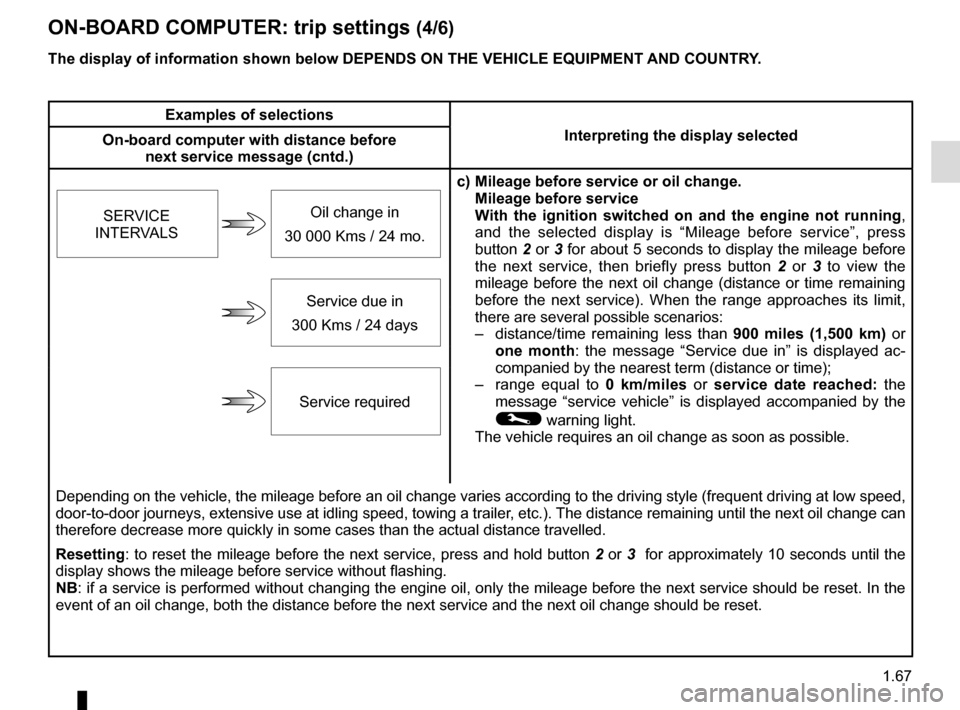
1.67
ON-BOARD COMPUTER: trip settings (4/6)
The display of information shown below DEPENDS ON THE VEHICLE EQUIPMENT \
AND COUNTRY.
Examples of selectionsInterpreting the display selected
On-board computer with distance before
next service message (cntd.)
c) Mileage before service or oil change.Mileage before service
With the ignition switched on and the engine not running ,
and the selected display is “Mileage before service”, press
button 2 or 3 for about 5 seconds to display the mileage before
the next service, then briefly press button 2 or 3 to view the
mileage before the next oil change (distance or time remaining
before the next service). When the range approaches its limit,
there are several possible scenarios:
– distance/time remaining less than 900 miles (1,500 km) or
one month : the message “Service due in” is displayed ac-
companied by the nearest term (distance or time);
– range equal to 0 km/miles or service date reached: the
message “service vehicle” is displayed accompanied by the
© warning light.
The vehicle requires an oil change as soon as possible.
SERVICE
INTERVALS
Oil change in
30 000 Kms / 24 mo.
Service due in
300 Kms / 24 days
Service required
Depending on the vehicle, the mileage before an oil change varies accord\
ing to the driving style (frequent driving at low speed ,
door-to-door journeys, extensive use at idling speed, towing a trailer, etc.). The distance remaining until the next oil change can
therefore decrease more quickly in some cases than the actual distance t\
ravelled.
Resetting: to reset the mileage before the next service, press and hold button 2 or 3 for approximately 10 seconds until the
display shows the mileage before service without flashing.
NB: if a service is performed without changing the engine oil, only the mi\
leage before the next service should be reset. In the
event of an oil change, both the distance before the next service and th\
e next oil change should be reset.
Page 74 of 268
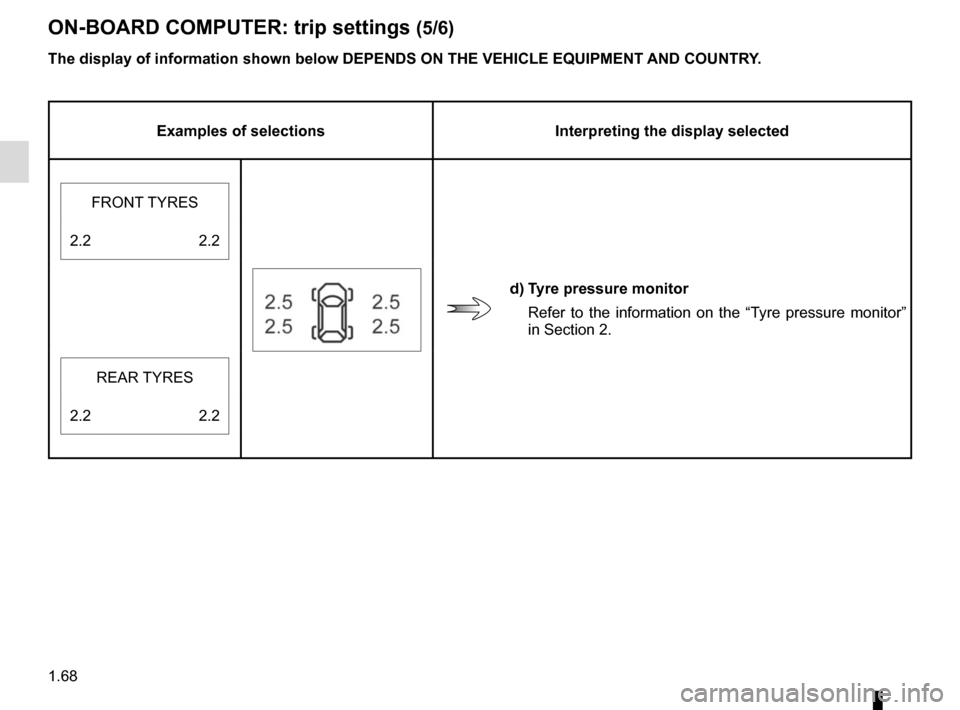
1.68
ON-BOARD COMPUTER: trip settings (5/6)
The display of information shown below DEPENDS ON THE VEHICLE EQUIPMENT \
AND COUNTRY.
Examples of selectionsInterpreting the display selected
d) Tyre pressure monitor
Refer to the information on the “Tyre pressure monitor”
in Section 2.
FRONT TYRES
2.2 2.2
REAR TYRES
2.2 2.2
Page 75 of 268
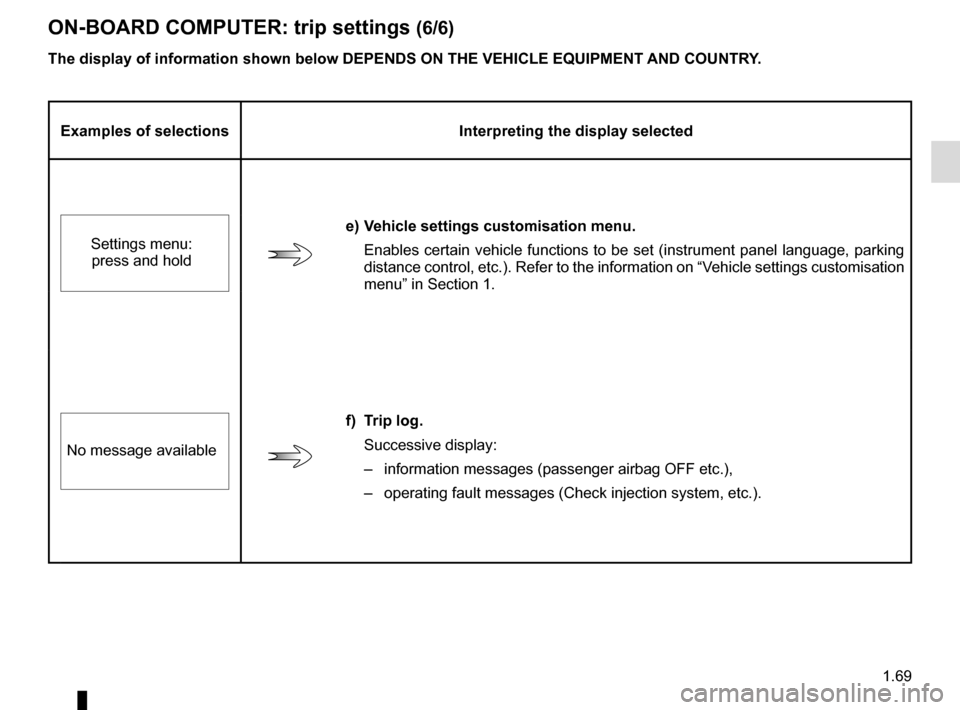
1.69
ON-BOARD COMPUTER: trip settings (6/6)
Examples of selectionsInterpreting the display selected
e) Vehicle settings customisation menu.
Enables certain vehicle functions to be set (instrument panel language,\
parking
distance control, etc.). Refer to the information on “Vehicle settings customisation
menu” in Section 1.
Settings menu:
press and hold
f) Trip log.
Successive display:
– information messages (passenger airbag OFF etc.),
– operating fault messages (Check injection system, etc.).
No message available
The display of information shown below DEPENDS ON THE VEHICLE EQUIPMENT \
AND COUNTRY.
Page 76 of 268
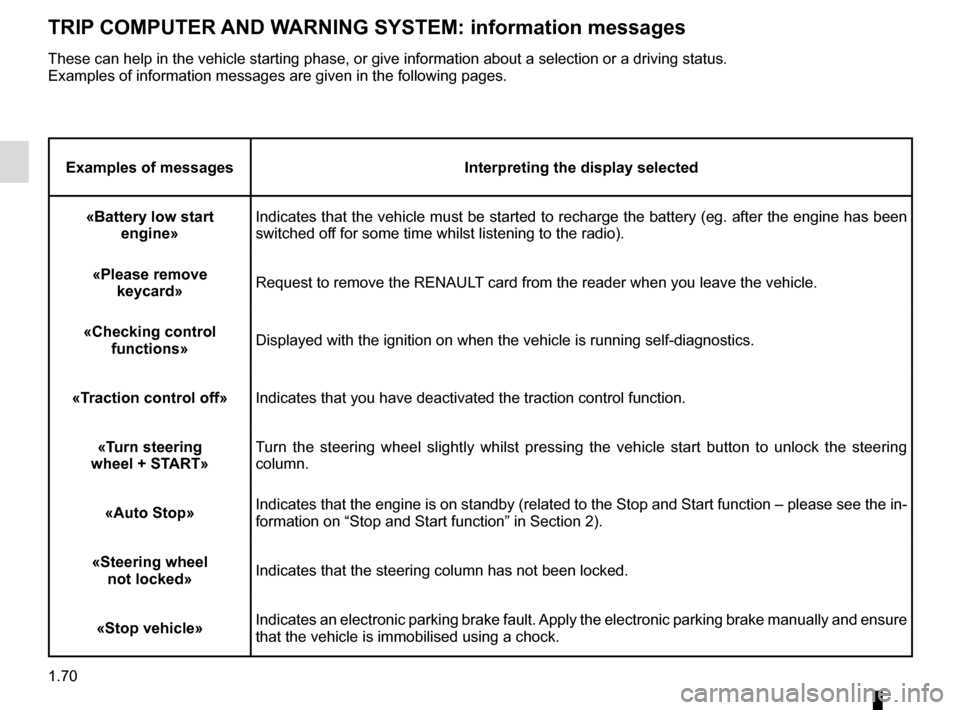
1.70
TRIP COMPUTER AND WARNING SYSTEM: information messages
Examples of messagesInterpreting the display selected
«Battery low start engine» Indicates that the vehicle must be started to recharge the battery (eg.\
after the engine has been
switched off for some time whilst listening to the radio).
«Please remove keycard» Request to remove the RENAULT card from the reader when you leave the vehicle.
«Checking control functions» Displayed with the ignition on when the vehicle is running self-diagnost\
ics.
«Traction control off» Indicates that you have deactivated the traction control function.
«Turn steering
wheel + START» Turn the steering wheel slightly whilst pressing the vehicle start button\
to unlock the steering
column.
«Auto Stop» Indicates that the engine is on standby (related to the Stop and Start \
function – please see the in-
formation on “Stop and Start function” in Section 2).
«Steering wheel not locked» Indicates that the steering column has not been locked.
«Stop vehicle» Indicates an electronic parking brake fault. Apply the electronic parking brake manually and ensure
that the vehicle is immobilised using a chock.
These can help in the vehicle starting phase, or give information about \
a selection or a driving status.
Examples of information messages are given in the following pages.
Page 77 of 268
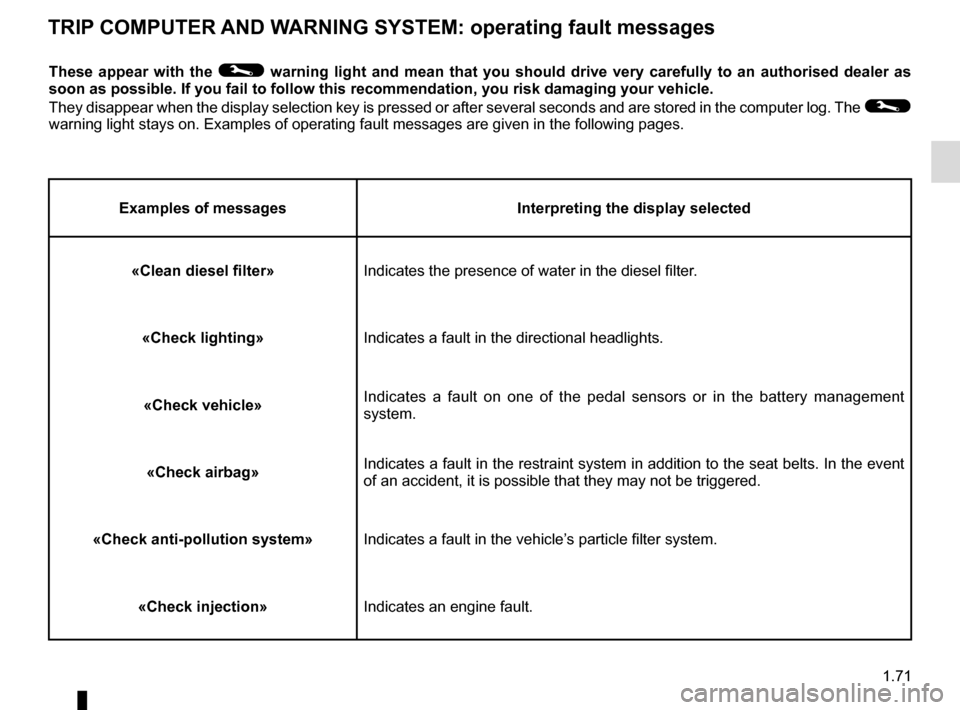
1.71
TRIP COMPUTER AND WARNING SYSTEM: operating fault messages
These appear with the © warning light and mean that you should drive very carefully to an author\
ised dealer as
soon as possible. If you fail to follow this recommendation, you risk da\
maging your vehicle.
They disappear when the display selection key is pressed or after severa\
l seconds and are stored in the computer log. The
©
warning light stays on. Examples of operating fault messages are given i\
n the following pages.
Examples of messages Interpreting the display selected«Clean diesel filter» Indicates the presence of water in the diesel filter.
«Check lighting» Indicates a fault in the directional headlights.
«Check vehicle» Indicates a fault on one of the pedal sensors or in the battery manageme\
nt
system.
«Check airbag» Indicates a fault in the restraint system in addition to the seat belts.\
In the event
of an accident, it is possible that they may not be triggered.
«Check anti-pollution system» Indicates a fault in the vehicle’s particle filter system.
«Check injection» Indicates an engine fault.
Page 78 of 268
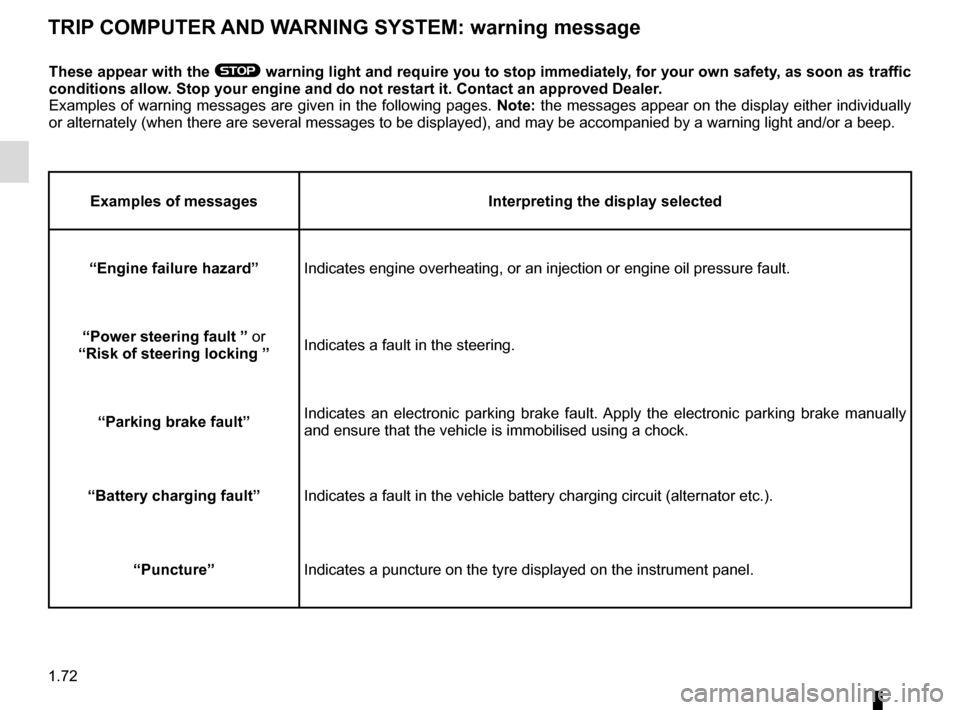
1.72
TRIP COMPUTER AND WARNING SYSTEM: warning message
These appear with the ® warning light and require you to stop immediately, for your own safety, as soon as traffic
conditions allow. Stop your engine and do not restart it. Contact an approved Dealer.
Examples of warning messages are given in the following pages. Note: the messages appear on the display either individually
or alternately (when there are several messages to be displayed), and \
may be accompanied by a warning light and/or a beep.
Examples of messages Interpreting the display selected
“Engine failure hazard” Indicates engine overheating, or an injection or engine oil pressure fau\
lt.
“Power steering fault ” or
“Risk of steering locking ” Indicates a fault in the steering.
“Parking brake fault” Indicates an electronic parking brake fault. Apply the electronic parking brake manually
and ensure that the vehicle is immobilised using a chock.
“Battery charging fault” Indicates a fault in the vehicle battery charging circuit (alternator e\
tc.).
“Puncture” Indicates a puncture on the tyre displayed on the instrument panel.
Page 79 of 268
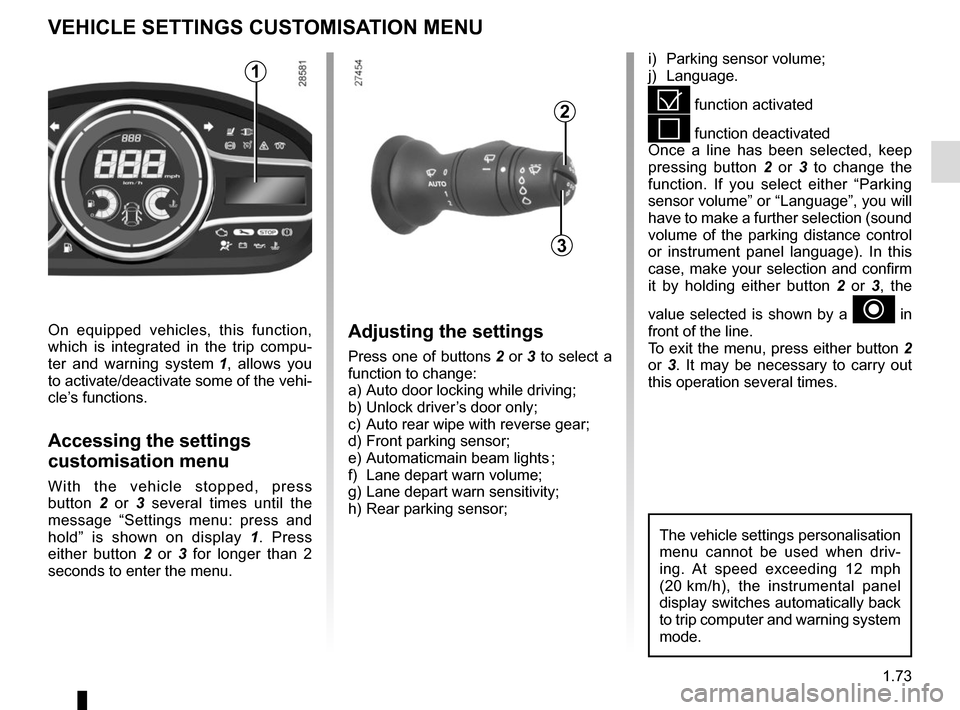
1.73
VEHICLE SETTINGS CUSTOMISATION MENU
i) Parking sensor volume;
j) Language.
= function activated
< function deactivated
Once a line has been selected, keep
pressing button 2 or 3 to change the
function. If you select either “Parking
sensor volume” or “Language”, you will
have to make a further selection (sound
volume of the parking distance control
or instrument panel language). In this
case, make your selection and confirm
it by holding either button 2 or 3, the
value selected is shown by a
~ in
front of the line.
To exit the menu, press either button 2
or 3. It may be necessary to carry out
this operation several times.
On equipped vehicles, this function,
which is integrated in the trip compu-
ter and warning system
1, allows you
to activate/deactivate some of the vehi-
cle’s functions.
Accessing the settings
customisation menu
With the vehicle stopped, press
button 2 or 3 several times until the
message “Settings menu: press and
hold” is shown on display 1. Press
either button 2 or 3 for longer than 2
seconds to enter the menu.
2
3
1
Adjusting the settings
Press one of buttons 2 or 3 to select a
function to change:
a) Auto door locking while driving;
b) Unlock driver’s door only;
c) Auto rear wipe with reverse gear;
d) Front parking sensor;
e) Automaticmain beam lights ;
f) Lane depart warn volume;
g) Lane depart warn sensitivity;
h) Rear parking sensor;
The vehicle settings personalisation
menu cannot be used when driv-
ing. At speed exceeding 12 mph
(20 km/h), the instrumental panel
display switches automatically back
to trip computer and warning system
mode.
Page 80 of 268
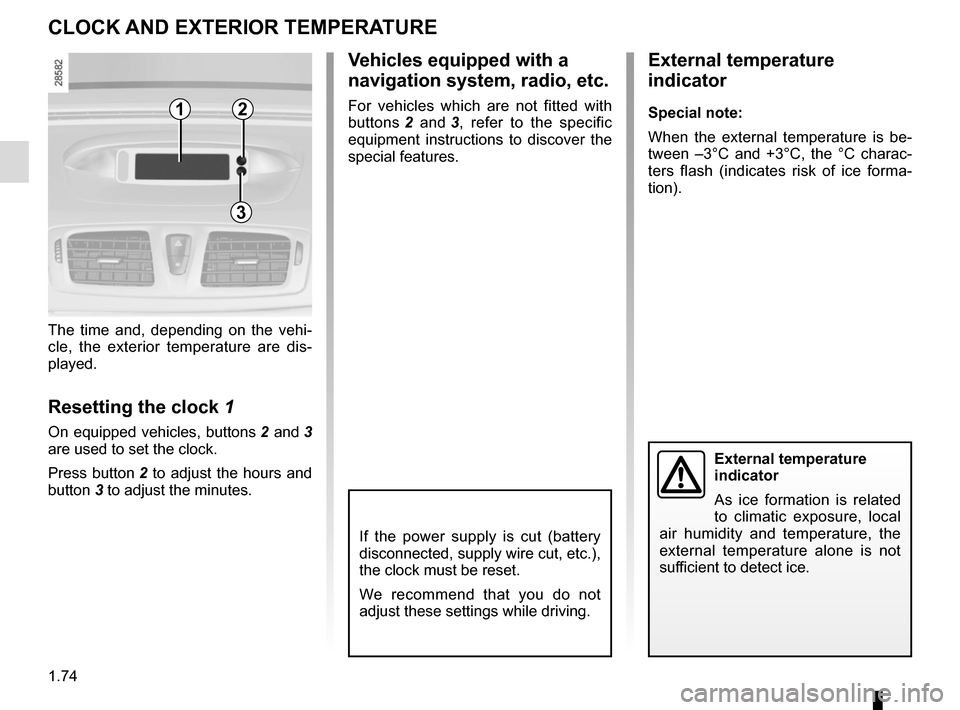
1.74
The time and, depending on the vehi-
cle, the exterior temperature are dis-
played.
Resetting the clock 1
On equipped vehicles, buttons 2 and 3
are used to set the clock.
Press button 2 to adjust the hours and
button 3 to adjust the minutes.
External temperature
indicator
As ice formation is related
to climatic exposure, local
air humidity and temperature, the
external temperature alone is not
sufficient to detect ice.
CLOCK AND EXTERIOR TEMPERATURE
External temperature
indicator
Special note:
When the external temperature is be-
tween –3°C and +3°C, the °C charac-
ters flash (indicates risk of ice forma-
tion).
Vehicles equipped with a
navigation system, radio, etc.
For vehicles which are not fitted with
buttons 2 and 3, refer to the specific
equipment instructions to discover the
special features.12
3
If the power supply is cut (battery
disconnected, supply wire cut, etc.),
the clock must be reset.
We recommend that you do not
adjust these settings while driving.